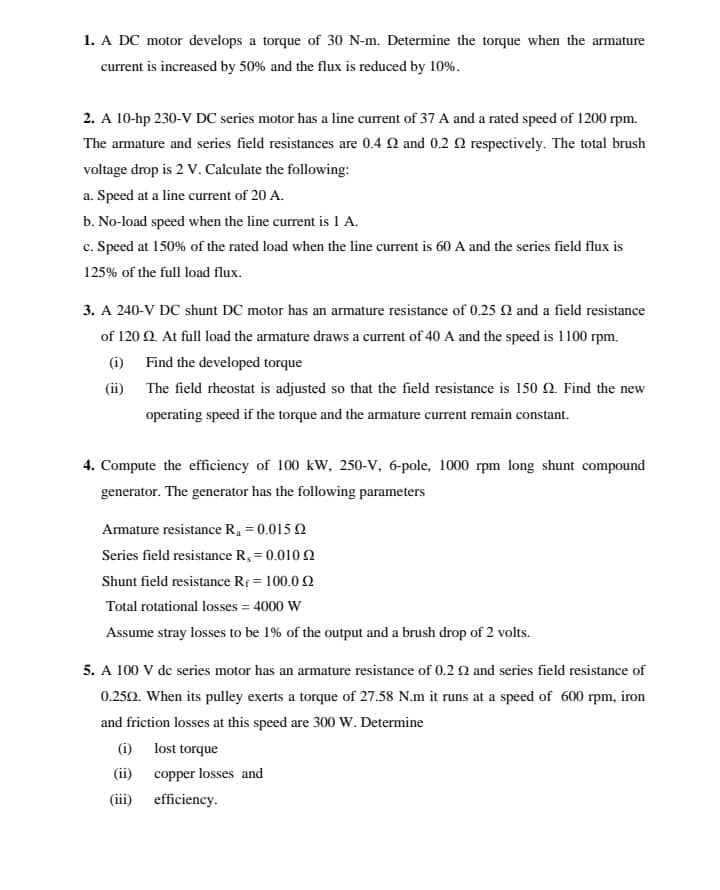4. Compute the efficiency of 100 kW, 250-V, 6-pole, 1000 rpm long shunt compound generator. The generator has the following parameters Armature resistance R₂ = 0.015 Series field resistance R,=0.0102 Shunt field resistance Rr = 100.0 2 Total rotational losses = 4000 W Assume stray losses to be 1% of the output and a brush drop of 2 volts.
4. Compute the efficiency of 100 kW, 250-V, 6-pole, 1000 rpm long shunt compound generator. The generator has the following parameters Armature resistance R₂ = 0.015 Series field resistance R,=0.0102 Shunt field resistance Rr = 100.0 2 Total rotational losses = 4000 W Assume stray losses to be 1% of the output and a brush drop of 2 volts.
Introductory Circuit Analysis (13th Edition)
13th Edition
ISBN:9780133923605
Author:Robert L. Boylestad
Publisher:Robert L. Boylestad
Chapter1: Introduction
Section: Chapter Questions
Problem 1P: Visit your local library (at school or home) and describe the extent to which it provides literature...
Related questions
Question
Please question 4

Transcribed Image Text:1. A DC motor develops a torque of 30 N-m. Determine the torque when the armature
current is increased by 50% and the flux is reduced by 10%.
2. A 10-hp 230-V DC series motor has a line current of 37 A and a rated speed of 1200 rpm.
The armature and series field resistances are 0.4 22 and 0.2 2 respectively. The total brush
voltage drop is 2 V. Calculate the following:
a. Speed at a line current of 20 A.
b. No-load speed when the line current is 1 A.
c. Speed at 150% of the rated load when the line current is 60 A and the series field flux is
125% of the full load flux.
3. A 240-V DC shunt DC motor has an armature resistance of 0.25 2 and a field resistance
of 120 2. At full load the armature draws a current of 40 A and the speed is 1100 rpm.
(i)
Find the developed torque
(ii)
The field rheostat is adjusted so that the field resistance is 150 2. Find the new
operating speed if the torque and the armature current remain constant.
4. Compute the efficiency of 100 kW, 250-V, 6-pole, 1000 rpm long shunt compound
generator. The generator has the following parameters
Armature resistance R₁ = 0.015
Series field resistance R, = 0.0102
Shunt field resistance R₁ = 100.0 2
Total rotational losses = 4000 W
Assume stray losses to be 1% of the output and a brush drop of 2 volts.
5. A 100 V de series motor has an armature resistance of 0.2 2 and series field resistance of
0.250. When its pulley exerts a torque of 27.58 N.m it runs at a speed of 600 rpm, iron
and friction losses at this speed are 300 W. Determine
lost torque
copper losses and
(i)
(ii)
(iii) efficiency.
Expert Solution
This question has been solved!
Explore an expertly crafted, step-by-step solution for a thorough understanding of key concepts.
Step by step
Solved in 4 steps with 13 images

Knowledge Booster
Learn more about
Need a deep-dive on the concept behind this application? Look no further. Learn more about this topic, electrical-engineering and related others by exploring similar questions and additional content below.Recommended textbooks for you

Introductory Circuit Analysis (13th Edition)
Electrical Engineering
ISBN:
9780133923605
Author:
Robert L. Boylestad
Publisher:
PEARSON

Delmar's Standard Textbook Of Electricity
Electrical Engineering
ISBN:
9781337900348
Author:
Stephen L. Herman
Publisher:
Cengage Learning

Programmable Logic Controllers
Electrical Engineering
ISBN:
9780073373843
Author:
Frank D. Petruzella
Publisher:
McGraw-Hill Education

Introductory Circuit Analysis (13th Edition)
Electrical Engineering
ISBN:
9780133923605
Author:
Robert L. Boylestad
Publisher:
PEARSON

Delmar's Standard Textbook Of Electricity
Electrical Engineering
ISBN:
9781337900348
Author:
Stephen L. Herman
Publisher:
Cengage Learning

Programmable Logic Controllers
Electrical Engineering
ISBN:
9780073373843
Author:
Frank D. Petruzella
Publisher:
McGraw-Hill Education

Fundamentals of Electric Circuits
Electrical Engineering
ISBN:
9780078028229
Author:
Charles K Alexander, Matthew Sadiku
Publisher:
McGraw-Hill Education

Electric Circuits. (11th Edition)
Electrical Engineering
ISBN:
9780134746968
Author:
James W. Nilsson, Susan Riedel
Publisher:
PEARSON

Engineering Electromagnetics
Electrical Engineering
ISBN:
9780078028151
Author:
Hayt, William H. (william Hart), Jr, BUCK, John A.
Publisher:
Mcgraw-hill Education,